4
Reproduction
ASEXUAL REPRODUCTION
Asexual reproduction is quite simple compared to sexual reproduction in that it requires only one organism; no partner is necessary. Therefore, in most asexual species, every mature individual can reproduce, enabling the population to increase far more rapidly than the otherwise comparable sexual species that require two individuals to reproduce.
Many organisms take full advantage of asexual reproduction. For instance, each time an amoeba divides, it produces two genetically identical replicas of itself. And many species of single-celled as well as multicellular organisms produce asexually reproductive cells known as spores that float in the air or water and eventually produce genetic replicas of the parent.
Another asexual mode of reproduction involves budding, as illustrated in Figure 4.1. In budding, part of the parent sprouts smaller offspring that separate and become distinct individuals. Many plants sprout new plants from leaves, roots, or some other part of the parent. This is called vegetative reproduction. In parthenogenesis, an egg can develop into an adult without being fertilized by a sperm cell.
Another form of asexual reproduction is fragmentation, in which part of an organism separates from the whole, and a new individual regenerates from that part. Such fragmentation sometimes occurs when an organism is in danger; pieces of the injured organism then regenerate into whole organisms. Starfish, for example, have this reproductive capacity. Worms and planaria can also fragment and then regenerate the missing portion of their body.
Cloning is another type of asexual reproduction that involves the production of copies that are genetically identical, although they may not look identical. This happens with many plant species – such as when one plant grows from a seed and then many other plants sprout up from the roots. Recent advances have made cloning humans possible.
There are many benefits as well as drawbacks to both asexual and sexual reproduction. Through natural selection, some sexually reproducing organisms have been able to survive and continue to flourish because they benefit from the genetic variability that this mode of reproduction promotes. For instance, should the environment change so that one variation were unable to survive, the entire species would perish if the species consisted of a clone. When, however, the species consists of genetically variable individuals within each population, different populations can adapt to a changing or variable environment. Although sexual reproduction is costly and somewhat inefficient in that it takes twice as many individuals to produce one set of offspring, the genetic variability that is maintained through sexual reproduction seems to have long-term benefits.
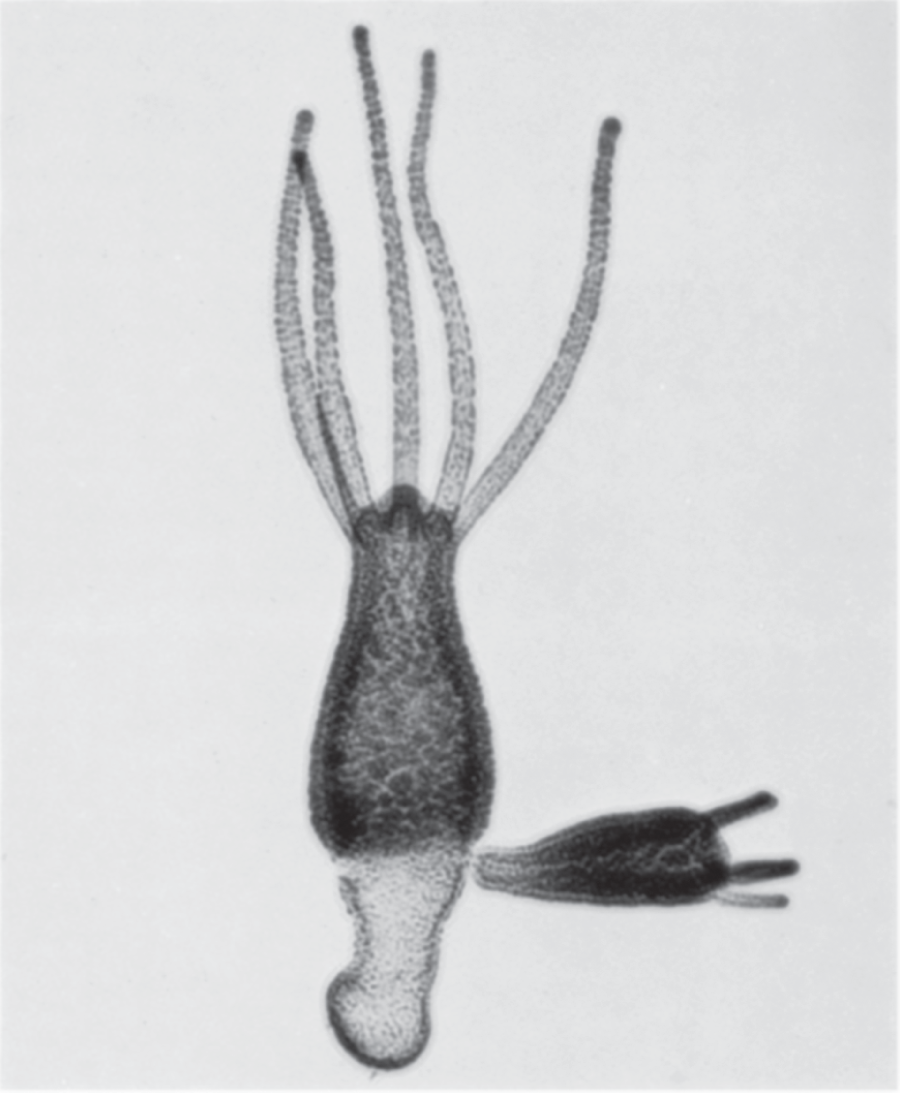
Figure 4.1 Budding of hydra is illustrated here. The upright and larger parent hydra is budding (sprouting) a smaller hydra that is growing out of the right of the parent.
SEXUAL REPRODUCTION
Sexual reproduction is costly to a species in that it requires both a male and a female to produce as many offspring as one asexual organism can produce, but there are also benefits to such an expensive reproductive mode. The method of reproduction is not always an either/or matter, however; some species reproduce asexually during one part of the year and sexually during another, thereby reaping the benefits of both methods. The complex series of physiological and behavioral changes associated with sexual reproduction are described below.
For sexual reproduction to occur, specialized cells from both the male and female come together and unite. Yet merely combining any two cells is not adequate. Rather, certain cells first undergo a peculiar type of cell division called meiosis, creating gametes called germ cells.
In animals, undifferentiated male germ cells are located in the testes. These cells undergo two meiotic divisions, called meiosis I and meiosis II, creating four sperm cells. Undifferentiated at first, these sperm cells, known as spermatids, undergo differentiation before becoming mature spermatozoa. This process, spermatogenesis, is the result of the division and maturation of a single diploid primary spermatocyte, producing four spermatozoa. In female animals, all the undifferentiated germ cells are located in the ovaries, where oogenesis occurs. Oogenesis comprises the series of steps that produce an egg from a primary oocyte, which is also called an ovum.
Figure 4.2 shows the process and products of meiosis and differentiation for both spermatogenesis and oogenesis. The entire process in which gametes (sperm and eggs) are developed through meiotic divisions and subsequent maturation and development is known as gametogenesis. In the testes of sexually mature male animals, the cells lining the seminiferous tubules are always dividing meiotically, producing haploid sperm cells; this process is termed spermatogenesis.
Gametogenesis in females is known as oogenesis, the process that produces eggs in the ovarian structures called follicles. The first meiotic division (meiosis I) produces two daughter cells of unequal size from a primary oocyte. The primary oocyte divides into a smaller first polar body and a larger secondary oocyte, which receives a greater share of the cytoplasm during this meiotic division. The first polar body either disintegrates or divides in the second part of meiosis (meiosis II), creating two second polar bodies that disintegrate. During meiosis II, the secondary oocyte divides into two parts unequally; less cytoplasm goes to a third second polar body, and more goes toward the ootid that then differentiates into an ovum, or egg.
In terms of weight, a human egg, though extremely tiny (much smaller than the head of a pin), is approximately 58,000 times heavier than a single sperm cell. In terms of length, a completely differentiated sperm cell is about one-third the diameter of a human egg. And if lined up side-by-side, there would be seven completely differentiated human eggs per millimeter. With its whip-like motion, the sperm's tail propels it through the mucosal lining of the vagina toward the ovum.
Only one sperm cell can fertilize each egg. When the sperm cell penetrates the egg, it contributes its haploid (sometimes called monoploid or 1N) genetic complement of chromosomal DNA to the haploid (1N) egg, creating a diploid (2N) zygote.
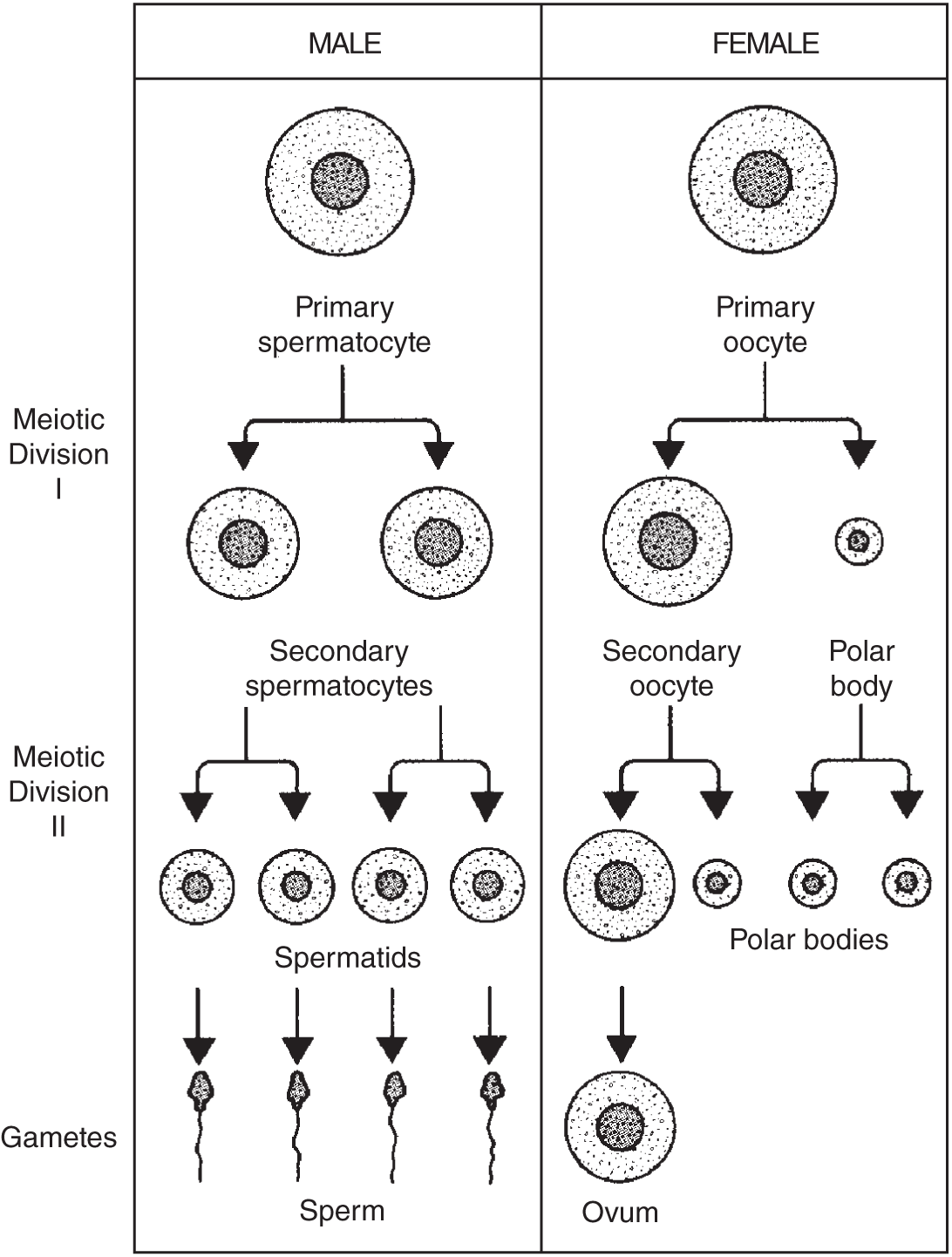
Figure 4.2 Gametogenesis is illustrated, showing how the process involves meiosis, which, in both the male and female, consists of a first and second meiotic division, forming either sperm or an ovum.
While spermatogenesis leads to four equal-sized sperm cells because the cytoplasm is divided equally during each meiotic division, oogenesis leads to a single large ovum because of the unequal cytoplasmic divisions. The greater amount of cytoplasm in the egg is used to nourish the early developmental stages, known as the embryo. A larger egg may also enhance the chances of being fertilized by a sperm cell. See Figure 4.3 for an illustration of spermatogenesis and oogenesis.

Figure 4.3 Spermatogenesis and oogenesis.
ALTERNATION OF GENERATION
As stated earlier, some organisms use both sexual and asexual reproductive strategies at different stages during their life cycle, a phenomenon termed alternation of generation. Such species benefit by possessing the capacity to reproduce asexually, rapidly creating many genetically identical clones, as well as the capacity to reproduce sexually, thus benefiting from genetic recombination.
Cells that develop via meiosis are not always used for reproduction, and the reverse is also true; that is, cells used for reproduction do not always develop via meiosis. For instance, in certain plant species, gametes are produced by mitosis because the cells that produce the gametes are already haploid. These haploid gametes then unite in fertilization to form diploid zygotes that divide mitotically, becoming diploid multicellular plants. Eventually, during this stage of their life cycle, haploid cells are produced via meiosis, and the resulting structures are called spores. These haploid spores divide mitotically, producing haploid multicellular plants that mature and produce gametes. In some primitive plants, haploid spores were immediately produced by diploid zygotes.
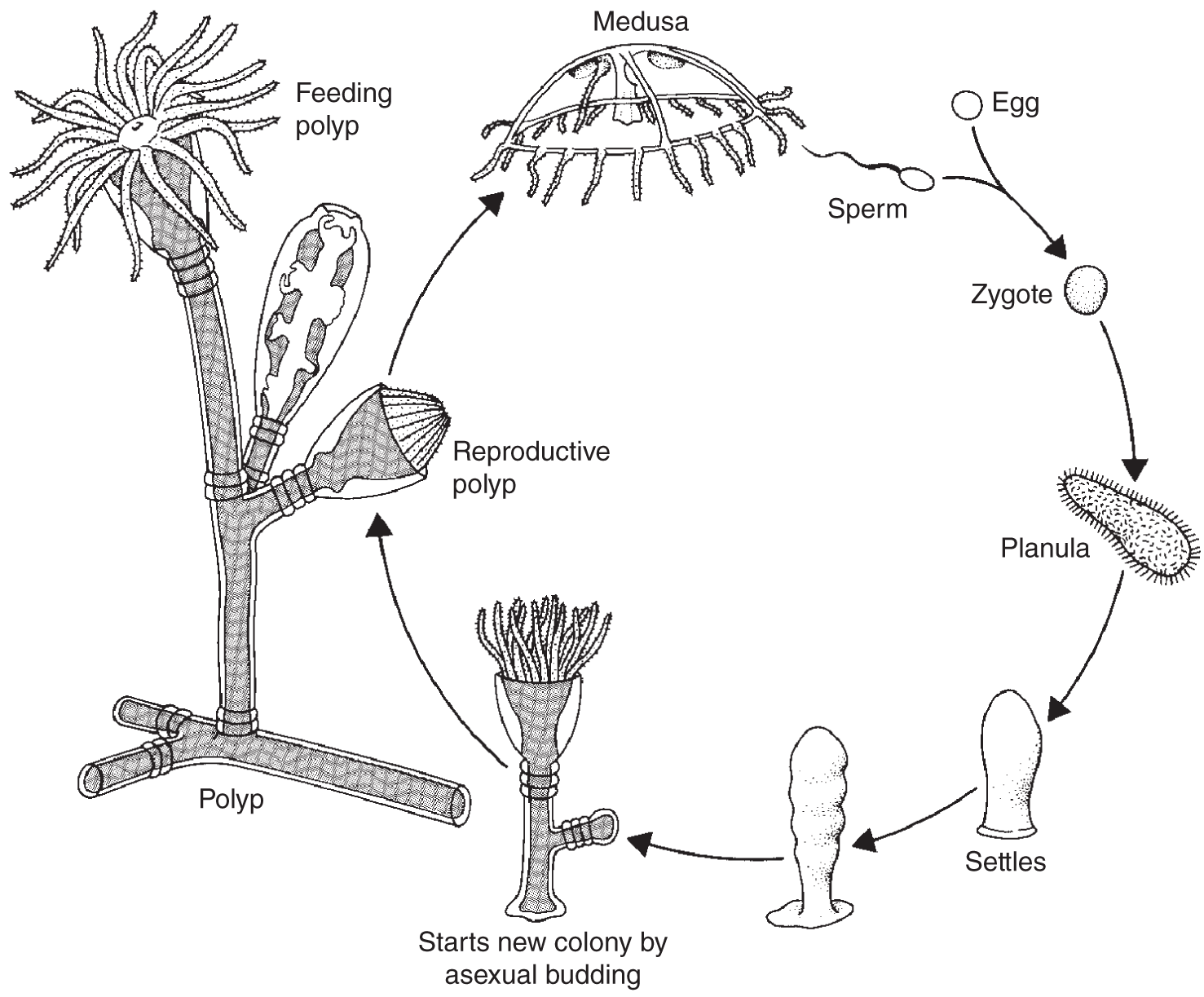
Figure 4.4 Alternation of generations in Obelia, which is a cnidarian (coelenterate). The polyp is part of the anchored colony (sessile). Reproductive polyps produce medusae, the free-swimming forms that produce eggs and sperm, which combine upon fertilization to form a zygote, which develops into a free-swimming planula larva. The planula eventually settles and through budding forms a new sessile colony.
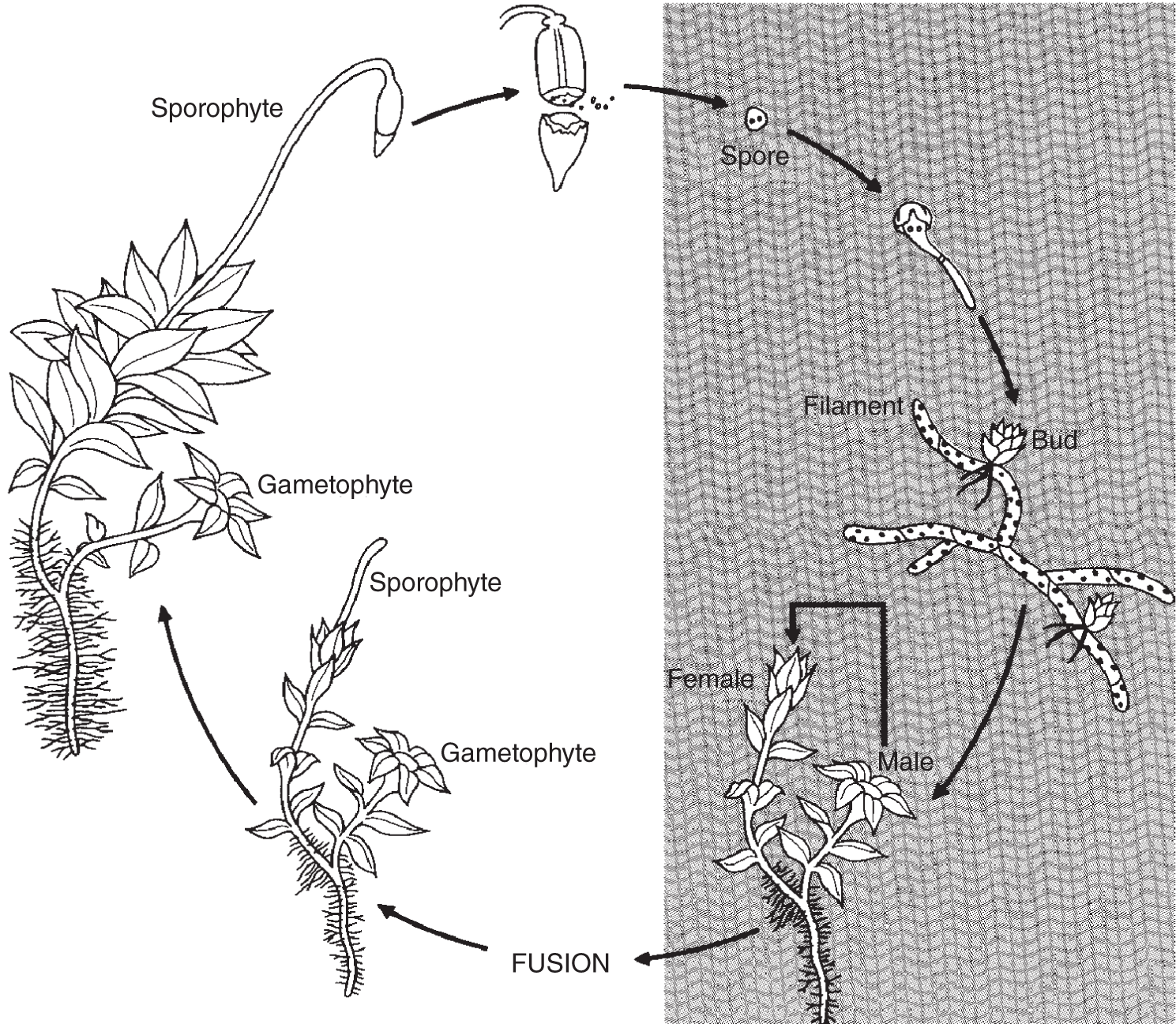
Figure 4.5 Life cycle of a moss.
Most variations on the alternation-of-generation theme are found in the plant kingdom, though there are analogous examples in many animal groups. For instance, certain coelenterates (cnidarians), or relatives of the jellyfish such as Hydra, are sessile, or attached to the substrate. Some species, such as Obelia, have both sessile and free-floating forms. This too is a type of alternation of generation, although in this case both life-forms are diploid. See Figure 4.4 for an illustration of alternation of generations in Obelia, and Figures 4.5 and 4.6 for the life cycles of a moss and a fern.
Abbreviated here is a list of key concepts recounting pertinent points from Chapter 3, on cell division, and from this chapter.
- When a multicellular, diploid organism produces gametes, the gametes can be a product only of meiosis. If the organism is already haploid, as in some plants, then the gametes are the product of mitosis.
- Haploid cells cannot divide meiotically; only diploid cells can undergo meiosis. Diploid and haploid cells can divide mitotically.
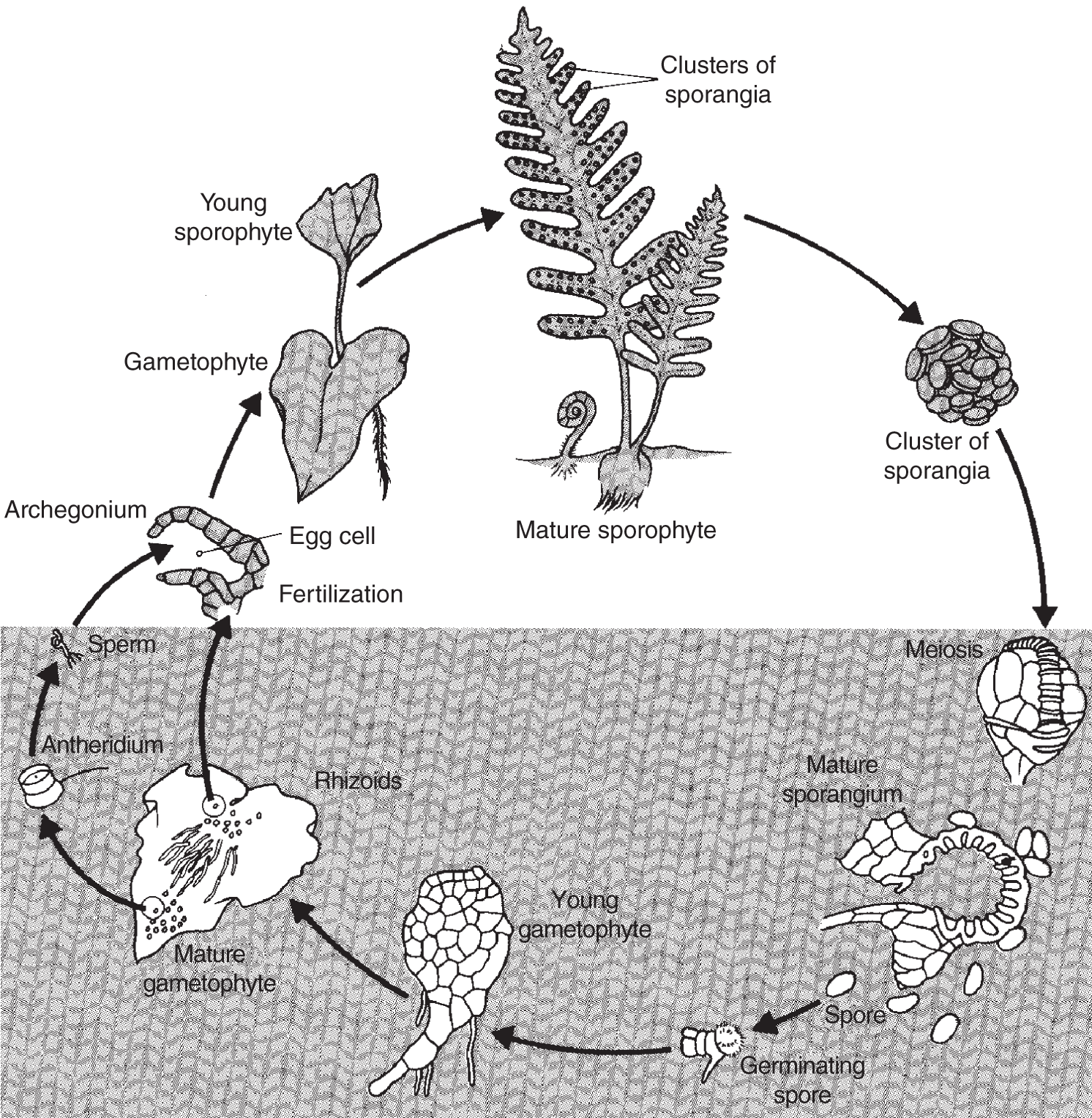
Figure 4.6 Life cycle of a fern.
- After fertilization, any organism produced by successive mitotic divisions is diploid.
- If successive mitotic divisions produce a multicellular organism after meiosis, but before fertilization, then the organism is haploid.
- The diploid phase in the life cycle of most animals is the dominant stage.
- The haploid stage in the life cycle of most animals represents the stage during which they exist solely as gametes.
- Animals do not produce spores. Spores are always haploid. To produce a multicellular organism, spores divide mitotically. Gametes unite through sexual reproduction, and fertilization occurs. Later, spores are produced that grow into multicellular organisms through mitotic cell division.
- In most primitive plants, the haploid stage in the life cycle is dominant.
- In most higher plants, the diploid stage is dominant.
HUMAN REPRODUCTION
The reproductive organs, sexual behavior, and related cycles of humans are similar in many respects to those of other animals, although there are many differences. Here, humans are used as a model to illustrate basic sexual anatomy, physiology, and behavior.
Male Reproductive Organs
As a species that reproduces sexually, humans produce gametes. The male gametes, or sperm, are produced in both testes (singular testis), which are located within the scrotal sac, or scrotum. The testes are composed of tubes, the seminiferous tubules, inside of which spermatogenesis, the production of sperm, occurs. Spermatogenesis is the series of meiotic divisions that creates the sperm, which in the case of humans is stored in the epididymis.
Upon adequate sexual stimulus, the penis becomes erect and sperm moves from the epididymis through the sperm duct, where it mixes with secretions from the seminal vesicles, the prostate gland, and the Cowper's glands, producing a mixture known as semen. During an orgasm, this fluid is discharged in an ejaculation.
Men produce sperm after puberty, which may occur any time between the ages of 12 and 17. Puberty usually occurs slightly earlier in girls than in boys. Before puberty, boys can have an erection and are capable of feeling a sensation quite similar to an orgasm. Erections occur even while the male fetus (unborn baby) is in the mother's womb (a term that is sometimes used interchangeably with uterus). See Figure 4.7 for an illustration of the human male reproductive system.
Female Reproductive Organs
The sex organs outside the body are known as the external genitalia. Together, the external female genitalia are called the vulva, which are composed of the protective, sensitive inner and outer labia (labia minora and labia majora). As in the male, urine flows through the urethra and out through the opening known as the urinary meatus. From back to front on the female, the first opening is the anus, the second is the vagina, and the third is the urinary meatus (see Figure 4.8). Above the urinary meatus is a small structure of which only the protruding tip is exposed. This is the clitoris, which swells considerably and hardens when engorged with blood. This is one of the more sensitive parts of the female anatomy, having approximately the same number of nerve endings as a penis. Sensitive to touch, the clitoris and labia are involved in the excitatory responses associated with intimate sexual contact.
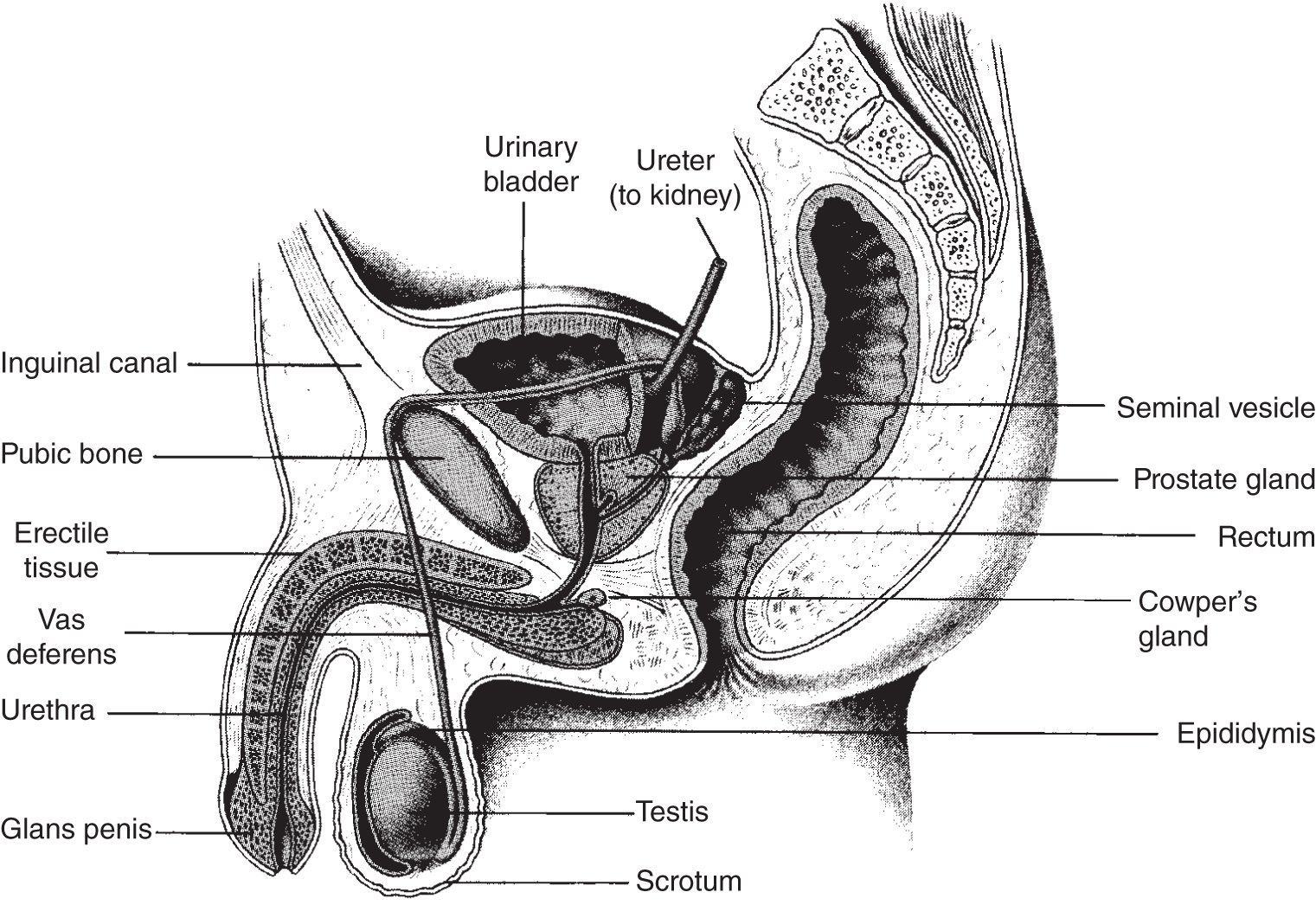
Figure 4.7 Reproductive system of the human male.

Figure 4.8 Reproductive system of the human female.
Whereas the urethra in the male passes through the center of the penis, the female's urethra opens just above the vaginal orifice. In the female, the urethra connects directly with the bladder, and its sole function is to pass urine. In the male, however, the urethra not only connects with the bladder but during an ejaculation serves as the duct that carries semen.
The vagina, sometimes referred to as the birth canal, is the passage leading from the uterus to the vulva. This is where the penis enters during sexual intercourse, and it is through this canal that the baby passes during birth. Girls are born with a thin membrane across the vagina that forms a border around the vaginal opening. This membrane, the hymen, has an opening through which such fluids as the menstrual flow pass.
During the foreplay – touching, fondling, and kissing – that precedes intercourse, a significant amount of natural lubrication is secreted by the vagina's mucosal lining. Some drops of clear fluid are also secreted through the male's urinary meatus, the hole at the tip of the penis.
Although the vagina may be thought of as an internal reproductive organ, it is in fact a continuation of the exterior of the body. The cervix, which is the lower opening of the uterus, is the meeting point of the body's exterior and interior. The uterus is an easily stretched, muscular organ where the embryo develops. When the time comes for the baby to be born, the muscles of the uterus contract, pushing the baby through the cervix and vagina (see Figure 4.9). The cervix is a series of ring-shaped muscles that become dilated or expanded when relaxed, increasing the diameter of the opening. Likewise, when contracted, the opening becomes smaller. This type of muscle is known as a sphincter muscle.
The tubes attached to the uterus, also called oviducts or fallopian tubes, connect the uterus to both of the ovaries, which lie on either side of the uterus. When girls are born, each of their immature ovaries already contains all the eggs they will ever have. Some estimates place the number of eggs at 500,000 per ovary, over two-thirds of which die before the female reaches puberty. Most of the rest die during the next several decades until the woman reaches the end of her child-bearing years at menopause, which usually occurs at about 45 years of age. During a woman's reproductive years, generally from the age of about 12 or 15 until menopause, one egg is released approximately every 28 days; altogether, this means a woman releases about 400–500 eggs during a lifetime.
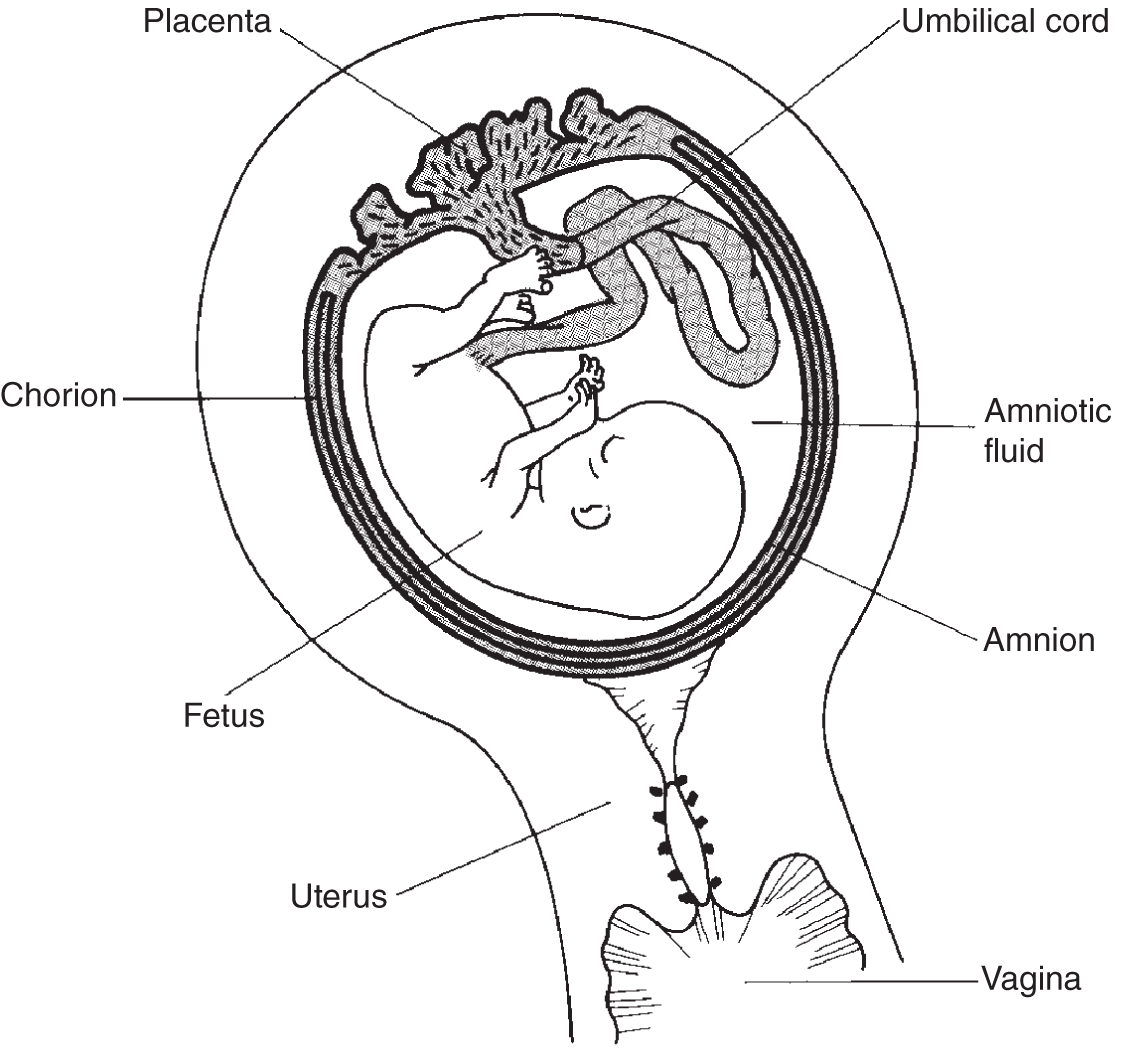
Figure 4.9 Human fetus and its fetal structures inside the mother's uterus.
Each month, one of the ovaries releases an egg, alternating with its pair from month to month. Following ovulation, the woman is fertile for several days, during which time she is capable of becoming pregnant.
When an ovary releases an egg, or ovulates, the egg slowly passes down the oviduct aided by the cilia toward the uterus. Because the vaginal mucosa are highly acidic, they retard microbial growth. Such acidity would also be injurious to sperm cells without the neutralizing effect of the semen. If coitus (sexual intercourse) occurs shortly after ovulation, some of the sperm moving through the vagina pass through the cervix and move up the uterus to the openings of the oviducts. If a sperm cell reaches the egg and penetrates the egg's membrane, resulting in fertilization, the fertilized egg, or zygote, passes down the oviduct to the uterus, where development continues until the baby is born.
Most other mammals – in fact, most other vertebrates – have sex during specific times. Unlike humans, some animals have mating seasons that occur just once a year. It is during these times that the animals become receptive or stimulated, and the appropriate nuptial behavioral patterns begin. Sexual displays of many types, those specific to each species, are elicited when males and females encounter one another. In contrast, instead of having sex only during specific times in a cycle, humans are receptive all year long.
Menstrual Cycle
Puberty is the point at which an individual is first capable of reproduction. Girls usually reach this stage when about 12 years old, and boys reach puberty about two years later. When a girl reaches puberty, she has her first menstrual period, and her periods recur every 28 days or so during the rest of her child-bearing years. It is the female monthly cycle that is known as the menstrual cycle.
Blood and cells that had lined the uterus are expelled in the menstrual flow, which is a result of the breakdown of the uterine lining. The outer cells slough off in a readying process that allows the uterus to regenerate a new lining receptive to implantation of a fertilized egg, creating a proper environment where an embryo can develop to full term. During estrus, when the cells are sloughed off, old cells and accompanying blood drain from the uterus through the vagina, out of which the discharge flows. This bleeding is controlled and normal, and is referred to as a woman's period. In humans, the entire menstrual cycle of uterine buildup and breakdown, involving the release of one egg, takes 28 days. The term “menstrual cycle” originated from the root menses, which means months (mensis means month). Menses is also used when referring to the menstrual period.
Many changes occur in hormonal concentrations during the menstrual cycle. Two parts of the monthly cycle are commonly known as the ovarian cycle and the uterine cycle. The relative levels of the two important hormones, estrogen and progesterone, are involved in regulating the events of the monthly cycle. Figure 4.10 explains the events in more detail.
The follicle is the part of the ovary that releases the egg. While the follicle develops, it secretes estrogen, which stimulates the uterus to thicken. Ovulation typically occurs on the fourteenth day of the cycle (counting begins from the first day of flow). The ruptured follicle becomes the corpus luteum, which secretes another hormone, progesterone, which stimulates the uterus to become ready to receive the fertilized egg. If the egg does not become fertilized, then progesterone secretion drops off, the thickened lining of the uterus sloughs off, and bleeding signals the beginning of the next menstrual cycle (see Figure 4.10).
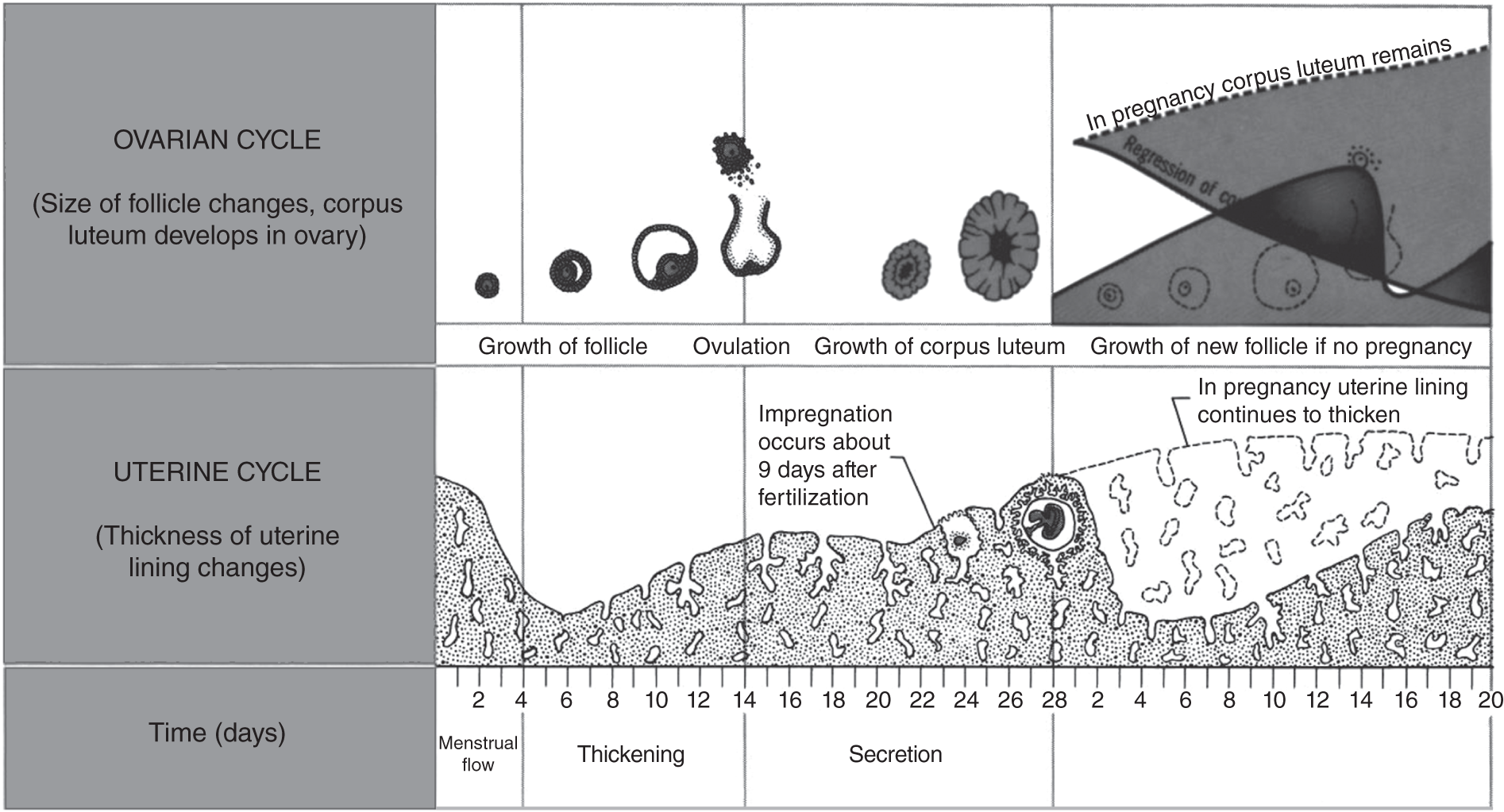
Figure 4.10 Monthly ovarian and uterine cycles. Four hormones are involved: FSH (follicle stimulating hormone) causes the maturity of the egg; estradiol causes the uterine lining to grow thicker; LH (luteinizing hormone) causes ovulation; and progesterone helps prepare the lining of the uterus for the fertilized egg. This is the “ovarian” cycle. If the egg is not fertilized, it passes through the uterus and disintegrates, the corpus luteum stops producing progesterone, and menses occurs. This is the “uterine” cycle.
KEY TERMS
| alternation of generation | labia majora | prostate gland |
| labia minora | puberty | |
| asexual reproduction | meiosis | regenerate |
| budding | meiosis I | scrotum |
| cervix | meiosis II | second polar bodies |
| cilia | menopause | secondary oocyte |
| clitoris | menses | semen |
| cloning | menstrual cycle | seminal vesicles |
| coitus | menstrual period | seminiferous tubules |
| corpus luteum | monoploid | sexual intercourse |
| Cowper's glands | mucosal lining | sexual reproduction |
| diploid zygote | 1N | sperm cells |
| egg | 2N | sperm duct |
| ejaculation | oogenesis | spermatids |
| embryo | outer labia | spermatogenesis |
| epididymis | ovarian cycle | spermatozoa |
| estrogen | ovaries | sphincter |
| estrus | oviducts | spores |
| fallopian tubes | ovulates | testes |
| fertile | ovum | urethra |
| first polar body | ootid | urinary meatus |
| follicles | parthenogenesis | uterine cycle |
| fragmentation | penis | uterus |
| gametogenesis | periods | vagina |
| germ cells | primary oocyte | vegetative reproduction |
| haploid | primary spermatocyte | vulva |
| hymen | womb | |
| inner labia | progesterone | zygote |
SELF-TEST
Multiple-Choice Questions
Asexual Reproduction
- Is cloning a form of sexual or asexual reproduction?
- Is parthenogenesis a type of asexual reproduction where an egg can or cannot develop into an adult without being fertilized by a sperm cell?
- Many plants reproduce __________, sprouting new plants from leaves or roots or some other part of the parent.
- by budding
- vegetatively
- parthenogenetically
- altruistically
- parsimoniously
- Another form of asexual reproduction involves __________, which occurs when part of an organism separates from the whole, and from this piece a new individual regenerates.
- fragmentation
- parthenogenesis
- parsimony
- altruism
- alternation of generation
Alternation of Generation and Sexual Reproduction
- In the testes of sexually mature male animals, the cells lining the __________ divide meiotically, producing haploid sperm cells.
- ovaries
- kidneys
- seminiferous tubules
- ureters
- urethras
- Gametogenesis in female animals is known as __________.
- follicular growth
- spermatogenesis
- oogenesis
- mitosis I
- mitosis II
- Some organisms use both sexual and asexual reproductive strategies at different stages during their life cycle, which is termed __________.
- sporation
- ovulation
- sex
- alternation of generation
- spermatogenesis
- When a multicellular, diploid organism produces gametes, the gametes can only be a product of __________.
- meiosis
- mitosis
- alternation of generation
- spermatogenesis
- oogenesis
- Animals __________ produce spores.
- sometimes
- always
- never
- meiotically
- mitotically
- The __________ phase in the life cycle of most animals is the dominant stage.
- monoploid
- haploid
- diploid
- triploid
- tetraploid
- In spermatogenesis, from one primary spermatocyte develop __________.
- two secondary spermatocytes
- four secondary spermatocytes
- two spermatids
- four spermatids
- a and d
- Upon completion of meiosis I and meiosis II in oogenesis, the primary oocyte has developed into __________.
- one secondary oocyte, one ootid, and one ovum
- one first polar body and three second polar bodies
- one secondary oocyte and one first polar body
- one ootid and three second polar bodies
- one ovum and three polar bodies
- When the genetic material in the __________ unite, the union is known as fertilization.
- gametes
- ootids
- secondary polar bodies
- spermatocytes
- oocytes
- In male vertebrates, the sperm cells are formed by the cells lining the __________.
- follicles
- spores
- zygotes
- seminiferous tubules
- mesothelium
- In the testes, the epithelial cells divide meiotically, producing __________ sperm cells.
- haploid
- diploid
- tetraploid
- haplodiploid
- all of the above
- The aggregation of cells in the ovary that releases the egg is known as a __________.
- menses
- follicle
- progesterone
- estrogen
- period
- Many types of plants and animals reproduce by a strategy that uses both sexual and asexual reproduction, known as __________.
- parthenogenesis
- sporangia
- oogenesis
- genetic recombination
- alternation of generation
- The haploid cells that plants sometimes produce meiotically are called __________.
- oocytes
- spermatocytes
- seeds
- spores
- zygotes
- An asexual mode of reproduction known as __________ occurs when part of the parent sprouts smaller offspring that then become separate individuals.
- budding
- sprouting
- germinating
- spreading
- parthenogenerating
- A form of asexual reproduction that produces genetically identical offspring is known as __________.
- germination
- gestation
- fragmentation
- cloning
- parthenogenesis
Human Reproduction
- The sac in which the testes are located is the __________.
- seminal vesicle
- prostate
- epididymis
- scrotum
- Cowper's sac
- The production of sperm occurs inside the __________.
- epididymis
- seminal vesicles
- prostate gland
- seminiferous tubules
- Cowper's gland
- Toward the top of each testis are some coiled tubes inside which sperm is stored; this area is known as the __________.
- seminal vesicle
- sperm duct
- prostate gland
- seminiferous tubules
- epididymis
- When a male ejaculates, sperm moves from the epididymis through the sperm duct and is then mixed with secretions from the __________ and __________.
- prostate gland, thymus gland
- vagina, seminal vesicle
- urethra, vulva
- Cowper's gland, urinary meatus
- seminal vesicle, prostate gland
- When sperm moves through the sperm duct and is mixed with the above secretions, it becomes known as __________.
- mucus
- spermicidal jelly
- prostaglandin
- semen
- urine
- The __________ passes through the length of the center of the penis.
- ureter
- urethra
- urinary meatus
- vulva
- vagina
- The passage leading from the uterus to the vulva is known as the __________.
- ureter
- urethra
- urinary meatus
- vulva
- vagina
- The __________ is a muscular organ where the embryo develops.
- cervix
- sphincter
- uterus
- ovary
- menopause
- The lower part of the uterus that extends into the vagina is the __________.
- ovary
- cervix
- oviduct
- uvula
- pubis
ANSWERS
- asexual
- can
- b
- a
- c
- c
- d
- a
- c
- c
- e
- e
- a
- d
- a
- b
- e
- d
- a
- d
- d
- d
- e
- e
- d
- b
- e
- c
- b
Questions to Think About
- Define asexual reproduction and discuss the different types that exist.
- Compare and contrast asexual and sexual reproduction: What are the benefits and shortcomings of each?
- Describe with the use of illustrations both types of gametogenesis: spermatogenesis and oogenesis.
- List the main human male reproductive structures (internal and external), and explain their function.
- List the main female reproductive structures (internal and external), and explain their function.
- Give the precise route that sperm takes from where it is formed to where it leaves the body.
- Give the precise route that an egg takes from where it is formed to where it becomes an embryo, and then the path it takes when the baby is born.
- Describe a complete menstrual cycle.